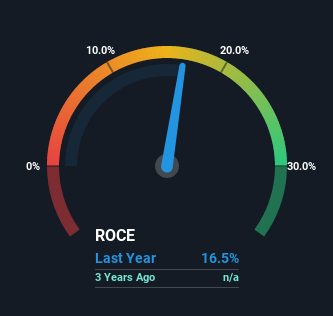- United States
- /
- Entertainment
- /
- NasdaqCM:SOGP
Investors Will Want Lizhi's (NASDAQ:LIZI) Growth In ROCE To Persist
There are a few key trends to look for if we want to identify the next multi-bagger. Firstly, we'd want to identify a growing return on capital employed (ROCE) and then alongside that, an ever-increasing base of capital employed. Basically this means that a company has profitable initiatives that it can continue to reinvest in, which is a trait of a compounding machine. With that in mind, we've noticed some promising trends at Lizhi (NASDAQ:LIZI) so let's look a bit deeper.
Return On Capital Employed (ROCE): What Is It?
If you haven't worked with ROCE before, it measures the 'return' (pre-tax profit) a company generates from capital employed in its business. The formula for this calculation on Lizhi is:
Return on Capital Employed = Earnings Before Interest and Tax (EBIT) ÷ (Total Assets - Current Liabilities)
0.16 = CN¥67m ÷ (CN¥776m - CN¥372m) (Based on the trailing twelve months to December 2022).
Thus, Lizhi has an ROCE of 16%. In absolute terms, that's a satisfactory return, but compared to the Entertainment industry average of 11% it's much better.
View our latest analysis for Lizhi

In the above chart we have measured Lizhi's prior ROCE against its prior performance, but the future is arguably more important. If you'd like to see what analysts are forecasting going forward, you should check out our free report for Lizhi.
SWOT Analysis for Lizhi
- Debt is well covered by earnings.
- Shareholders have been diluted in the past year.
- Annual revenue is forecast to grow faster than the American market.
- Debt is not well covered by operating cash flow.
What The Trend Of ROCE Can Tell Us
Lizhi has recently broken into profitability so their prior investments seem to be paying off. About five years ago the company was generating losses but things have turned around because it's now earning 16% on its capital. Not only that, but the company is utilizing 362% more capital than before, but that's to be expected from a company trying to break into profitability. This can indicate that there's plenty of opportunities to invest capital internally and at ever higher rates, both common traits of a multi-bagger.
In another part of our analysis, we noticed that the company's ratio of current liabilities to total assets decreased to 48%, which broadly means the business is relying less on its suppliers or short-term creditors to fund its operations. So this improvement in ROCE has come from the business' underlying economics, which is great to see. However, current liabilities are still at a pretty high level, so just be aware that this can bring with it some risks.
Our Take On Lizhi's ROCE
Overall, Lizhi gets a big tick from us thanks in most part to the fact that it is now profitable and is reinvesting in its business. Although the company may be facing some issues elsewhere since the stock has plunged 87% in the last three years. In any case, we believe the economic trends of this company are positive and looking into the stock further could prove rewarding.
Like most companies, Lizhi does come with some risks, and we've found 3 warning signs that you should be aware of.
While Lizhi may not currently earn the highest returns, we've compiled a list of companies that currently earn more than 25% return on equity. Check out this free list here.
New: Manage All Your Stock Portfolios in One Place
We've created the ultimate portfolio companion for stock investors, and it's free.
• Connect an unlimited number of Portfolios and see your total in one currency
• Be alerted to new Warning Signs or Risks via email or mobile
• Track the Fair Value of your stocks
Have feedback on this article? Concerned about the content? Get in touch with us directly. Alternatively, email editorial-team (at) simplywallst.com.
This article by Simply Wall St is general in nature. We provide commentary based on historical data and analyst forecasts only using an unbiased methodology and our articles are not intended to be financial advice. It does not constitute a recommendation to buy or sell any stock, and does not take account of your objectives, or your financial situation. We aim to bring you long-term focused analysis driven by fundamental data. Note that our analysis may not factor in the latest price-sensitive company announcements or qualitative material. Simply Wall St has no position in any stocks mentioned.
About NasdaqCM:SOGP
Sound Group
Provides audio entertainment, podcast, advertising, and others in the People's Republic of China.
Flawless balance sheet with acceptable track record.
Market Insights
Community Narratives





